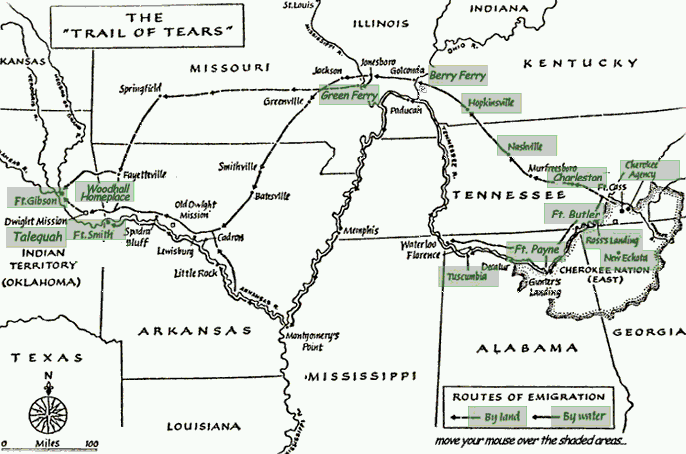

The Cherokee Nation - largest of the Five Civilized Tribes of the Southeast - is a people of Iroquoian lineage. The Cherokee, who called themselves 'Ani'-Yun' wiya' - 'Principal People' - the 'Keetoowah' - 'People of Kituhwa' - or Tsalagi from their own name for the Cherokee Nation - migrated to the Southeast from the Great Lakes Region.
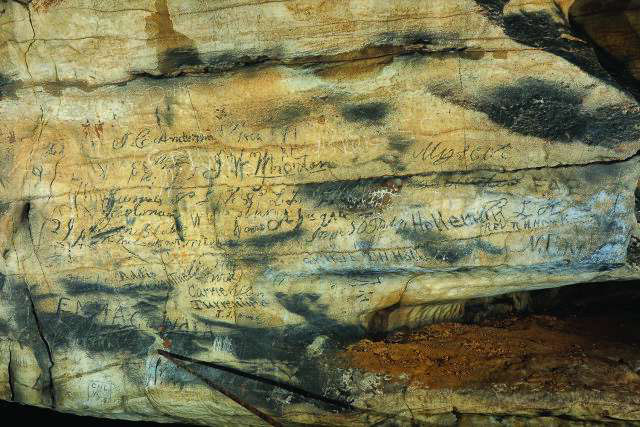
Researchers interpret Cherokee inscriptions in Alabama cave PhysOrg - April 12, 2019
For the first time, a team of scholars and archaeologists has recorded and interpreted Cherokee inscriptions in Manitou Cave, Alabama. These inscriptions reveal evidence of secluded ceremonial activities at a time of crisis for the Cherokee, who were displaced from their ancestral lands and sent westward on the Trail of Tears in the 1830s.
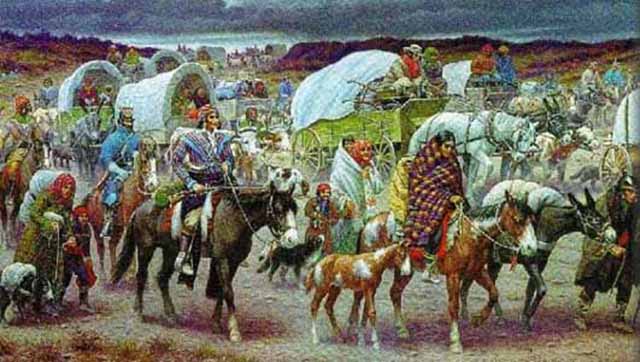
Trail of Tears
1450 - First Cherokee enter the state in the vicinity of Traveler's Rest. Tugaloo Old Town is the first major Cherokee village.
1540-1 De Soto "visits" the Cherokee and is supposedly one of the first whites seen by the tribe, although written descriptions of the tribe by the Spanish note the wide range of colors in the tribe, from "negro" (black) to light skinned and "fair," according to Moyano and Pardo.
1650 - Cherokee commanded more than 40,000 square miles in the southern Appalachians by 1650 with a population estimated at 22,500.
1715 - Massive uprising against North and South Carolina
1721 - First treaty with whites - South Carolina
1738 - Smallpox eradicates 25% of the Cherokee Nation. Nancy Ward is born
1753 - Smallpox epidemic
1755 - Battle of Taliwa - Accounts differ on exact events, however, the Creek, who greatly outnumber the Cherokee, attack the Cherokee line five times. During the fifth attack elderly Cherokee leader Kingfisher is slain. His teenage wife picks up his weapon, and chanting a Cherokee war song, Nancy Ward leads the Cherokee to victory, routing the Creek. The battle marked successful expulsion of the Creek from much of North Georgia. The only major remaining Creek settlement was near present Rome, Georgia.
1760-1762 - Cherokee War (SC)
1773 - First cession of Cherokee land in Georgia
1776-1783 - Impressed by the British during the French and Indian War, the Cherokee side with them during the American Revolution. The price for the decision is immense. Beginning at about the time of the American Revolutionary War, divisions over continued accommodation of encroachments by white settlers, despite repeated violations of previous treaties, caused some Cherokee to begin to leave The Cherokee Nation. These dissidents became known as the Chickamauga. Led by Chief Dragging Canoe, the Chickamauga made alliances with the Shawnee and engaged in raids against colonial settlements, aided by the British. Colonel Pickens destroyed Long Swamp village (1782) and forced the Cherokee to cede land to settlers.
1785 Treaty of Hopewell (SC) - The Cherokee thought this would be the end of the settlers' invasion of Cherokee land. Within 3 years bitter fighting had erupted as settlers continued to move into the Cherokee Nation. This treaty is the basis for the term "Talking Leaves." [See below] Cherokee felt that written words were like leaves, when they were no longer of use they withered and died.
John Ross is born.
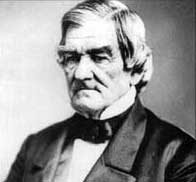
Ross, also known as Kooweskoowe, was a leader of the Cherokee Native American tribe. Ross was born near Lookout Mountain, Tennessee, the son of a Scotsman who had gone to live among the Cherokee during the American Revolution. John Ross's mother was 3/4 Scottish as well.
At the age of twenty, after having completed his education, he was appointed as Indian agent to the western Cherokee and sent to Arkansas. He served as an adjutant in a Cherokee regiment during the War of 1812 and participated in fighting at the Battle of Horseshoe Bend against the British-allied Creek tribe.
Ross relocated to Georgia and was chosen as a member of the Cherokee national council in 1817, becoming its president two years later and serving in that capacity for seven years. After this he became assistant chief of the eastern Cherokee, becoming principal chief the following year and serving as such until 1839, participating in the drafting of the Cherokee constitution in 1827.
During his tenure as chief he opposed displacement of the tribe from its native lands, a policy of the United States government known as Indian Removal. However, Ross's political rival Major Ridge signed an unauthorized removal treaty with the U.S. in 1836. Ross unsuccessfully lobbied against enforcement of the treaty, but those Cherokees who did not emigrate to the "Indian Territory" by 1838 were forced to do so by General Winfield Scott, an episode that came to be known as the Trail of Tears. Accepting defeat, Ross convinced General Scott to have supervision of much of the removal process turned over to Ross.
In the Indian Territory, Ross helped draft a constitution for the entire Cherokee nation in 1839, and was chosen as chief of the nation. He would remain chief until his death.
1791 Treaty of Holston-Cherokee cede land in eastern Tennessee in exchange for President Washington's guarantee that the Cherokee Nation will never again be invaded by settlers. This treaty forces Americans to obtain passports to enter Cherokee lands, and granted Cherokee the right to evict settlers.
1792 The town of Hightower moves from the vicinity of Rome, Georgia to present-day Cartersville, further east on the Etowah River after a brutal attack on the village by Tennessee governor John Sevier.
1799-1804 Building of the Augusta to Nashville Road, later known as the Federal Road.
1801 Return J. Meigs appointed "indian agent." Morovians start mission at Spring Place.
1802 President Thomas Jefferson agrees with the state of Georgia to removal of all American Indians in exchange for the state's claim of western lands.
1804 Cherokee cede Wafford's Tract.
1806 Start of a complex series of events known as Revolt of the Young Chiefs
1811 New Madrid earthquake. Actually 3 separate earthquakes with an epicenter near the town of New Madrid, Missouri in the southeastern border with Kentucky. The quakes were felt throughout the Cherokee Nation and sparked what is best described as a religious revival among the Cherokee. Writer James Mooney would call this movement the "Ghost Dance," after a similar Western Indian revival.
1812 Shawnee warrior Tecumseh agitates American Indians on the frontier to rise up and destroy the settlers. A faction of the Creek Indians, the "Red Sticks," revolt, attacking Fort Mims, Alabama and massacre 250 men, women and children.
1 813-1814 Cherokee warriors fight alongside future president Andrew Jackson during two campaigns (5 major battles) against the Red Sticks, saving both his army and his life in separate battles.
1814 Jackson demands cessions of 2.2 million acres from the Cherokee.
1817 Cession of land east of the Unicoi Turnpike. (Treaty of Turkey Town, instead of the 2.2 million acres demanded by Jackson.)
1819 Final cession of land in Georgia, and part of a much larger cession, the Cherokee give up claims to all land east of the Chattahoochee River.
1821 Cherokee warrior Sequoyah finishes his work on a written language (syllabary) for the tribe. Within six months more than 25% of the Cherokee Nation learns how to read and write.
1822 Georgia begins press for cession of remaining Cherokee lands, citing Jefferson's
1802 commitment to the state.
1828 Gold discovered in Georgia. This discovery was on Cherokee land ceded to the U. S. in 1817 (Duke's Creek), however, gold was soon found inside the Cherokee Nation; Publication of the Cherokee Phoenix begins with Elias Boudinot, editor.
1830 - Cherokees were displaced from their ancestral lands in North Georgia and the Carolinas primarily as a result of the Gold Rush around Dahlonega, Georgia in the 1830's. Cherokee evict encroachers in Beaver Dam on Cedar Creek, a few miles south of present-day Rome, Georgia. Passage of the Indian Removal Act.
1831 Chief Justice John Marshall rules that the Cherokee have no standing to file suit in the United States in Cherokee Nation vs. Georgia. He then instructs attorney William Wirt on how to correctly file; Samuel Worcester and others arrested for violation of Georgia law requiring whites to get permits to work in the Cherokee territory.
1832 The Supreme Court of the United States declares the Cherokee Nation to be sovereign (Worcester vs. Georgia). This has constitutional implications, disallowing the state of Georgia from passing any law governing the Cherokee; Elias Boudinot resigns as publisher of the Cherokee Phoenix under pressure from John Ross because of his editorial support for removal;Georgia's sixth land lottery and the gold lottery.
1834 The Georgia Guard destroys the printing press in the offices of The Cherokee Phoenix.
1835 Ross and John Howard Payne, in Red Clay, Tennessee, are illegally detained by the Georgia Guard. Dec. 29 Treaty of New Echota signed in Elias Boudinot's home by members of the Treaty Party.
1838 Deadline for voluntary removal. Georgia Guard had begun round-up 5 days earlier. U. S. forces under command of Winfield Scott begin roundup in Georgia, Tennessee, Alabama, and North Carolina. Cherokee are herded into "forts," gradually making their way north to the Cherokee Agency in southeastern Tennessee.
Once the Cherokees reached Indian Territory (now Oklahoma), tensions ran high and the suspension of the Cherokee Blood Law was ignored. On June 22, 1839, after the adjournment of a tribal meeting, some of the prominent signers of the Treaty of New Echota were assassinated, including the drafter of the Blood Law, Major Ridge, along with John Ridge and Elias Boudinot. This started 15 years of civil war amongst the Cherokees. One of the notable survivors was Stand Watie, who became a Confederate general during the American Civil War. The Cherokees were one of the five "civilized tribes" that concluded treaties with, and were recognized, by the Confederate States of America.
In 1848 a group of Cherokee set out on an expedition to California looking for new settlement lands. The expedition followed the Arkansas River upstream to Rocky Mountains in present-day Colorado, then followed the base of mountains northward into present-day Wyoming before turning westward. The route become known as the Cherokee Trail. The group, which undertook gold prospecting in California, returned along the same route the following year, noticing placer gold deposits in tributaries of the South Platte. The discovery went unnoticed for a decade but eventually became of the primary sources of the Colorado Gold Rush of 1859.
Other Cherokees in western North Carolina served as part of Thomas' Legion, a unit of approximately 1,100 men of both Cherokee and white origin, fighting primarily in Virginia, where their battle record was outstanding. Thomas' Legion was the last Confederate unit to surrender in North Carolina, at Waynesville, North Carolina on May 9, 1865.
The Cherokee Nation citizens lost their right to elect their own chief in 1907 when Oklahoma became a state. Various chiefs were appointed by the Presidents until 1970 when the Cherokees regained their right to elect their own government via a Congressional Act signed by President Nixon. W. W. Keeler was the first elected chief of The Cherokee Nation. Keeler, who was also the President of Phillips Petroleum was succeeded by Ross Swimmer, Wilma Mankiller, Joe Byrd and Chad Smith who is currently the chief of The Cherokee Nation
The Cherokee were divided into seven clans. People in a clan had to marry outside of his or her clan. Then, the male lived with his wife's family (matriarchial).
Before the Europeans came over, they lived together in square houses made of bark, wood, earth, and clay. Later, they lived in log cabins.
Their economy consisted of the cultivation of corn, beans, and squash. Also, hunting and slash-and-burn agriculture was a large part of their economy. Their only domesticated animal was the dog, until the Europeans brought horses over.
The Cherokees held many ceremonies. One of their ceremonies marked the changing of rulers between the Red and White Organization. Another ceremony consisted of nightlong dancing before going to war. After war, they had rituals of purification before they returned to their daily routine.
For leisure, the Cherokees played a game with rackets and a ball. Ritual fasting and bleeding was associated with the game. Along with this they had ceremonies called harvest feast and an observance of the new year.
Cherokee life and culture greatly resembled that of the Creek and other Indians of the Southeast. The Cherokee nation was composed of a confederacy of red (war) and white (peace) towns. The chiefs of the red towns were subordinated to a supreme war chief, while the officials of the white towns were under the supreme peace chief. The white towns provided sanctuary for wrongdoers; war ceremonies were conducted in red towns.
When first encountered by Europeans in the mid-16th century, the Cherokee possessed a variety of stone implements including knives, axes, and chisels. They wove baskets, made pottery, and cultivated corn (maize), beans, and squash. Deer, bear, and elk furnished meat and clothing. Cherokee dwellings were windowless log cabins roofed with bark, with one door and a smokehole in the roof. A typical Cherokee town had between 30 and 60 such houses and a council house where general meetings were held and the sacred fire burned. An important religious ceremony was the Busk, or Green Corn, festival, a first-fruits and new-fires rite.
The Cherokee wars and treaties, a series of battles and agreements around the period of the U.S. War of Independence, effectively reduced Cherokee power and landholdings in Georgia, eastern Tennessee, and western North and South Carolina, freeing this territory for speculation and settlement by the white man. Numbering about 22,000 tribesmen in 200 villages throughout the area, the Cherokee had since the beginning of the 18th century remained friendly to the British in both trading and military affairs.
In 1773 the Treaty of Augusta, concluded at the request of both Cherokee and Creek Indians, ceded more than 2,000,000 tribal acres in Georgia to relieve a seemingly hopeless Indian indebtedness to white traders. In 1775 the Overhill Cherokee were persuaded at the Treaty of Sycamore Shoals to sell an enormous tract of land in central Kentucky.
Although this agreement with the Transylvania Land Company violated British law, it nevertheless became the basis for the white takeover of that area. Threatened by colonial encroachment upon their hunting grounds, the Cherokee announced at the beginning of the American Revolution their determination to support the crown.
Despite British attempts to restrain them, in July 1776 a force of 700 Cherokee under Chief Dragging-canoe attacked two U.S.-held forts in North Carolina: Eaton's Station and Ft. Watauga. Both assaults failed, and the tribe retreated in disgrace. These raids set off a series of attacks by Cherokee, Creek, and Choctaw on frontier towns, eliciting a vigorous response by militia and regulars of the Southern states during September and October.
At the end of this time, Cherokee power was broken, crops and villages destroyed, and warriors dispersed. The humiliated Indians could win peace only by surrendering vast tracts of territory in North and South Carolina at the Treaty of DeWitt's Corner (May 20, 1777) and the Treaty of Long Island of Holston (July 20, 1777). As a result, peace reigned on this frontier for the next two years.
When Cherokee raids flared up again in 1780 during American preoccupation with British armed forces elsewhere, punitive action led by Col. Arthur Campbell and Col. John Sevier soon brought them to terms again. At the second Treaty of Long Island of Holston (July 26, 1781), previous land cessions were confirmed and additional territory yielded.
After 1800 the Cherokee were remarkable for their assimilation of white culture. The Cherokee formed a government modelled on that of the U.S. Under Chief Junaluska they aided Andrew Jackson against the Creek (see Creek War), particularly in the Battle of Horseshoe Bend. They adopted white methods of farming, weaving, and home building.
Perhaps most remarkable of all was the syllabary of the Cherokee language, developed in 1821 by Sequoyah, a half-blooded Cherokee who had served with the U.S. Army in the Creek War. The syllabary - a system of writing in which each symbol represents a Syllable was so successful that almost the entire tribe became literate within a short time. For years, many people wrote transliterated Cherokee on the Internet or used poorly inter-compatible fonts to type out the syllabary. However, since the fairly recent addition of the Cherokee syllables to Unicode, the Cherokee language is experiencing a renaissance in its use on the Internet. Cherokee Code Talkers
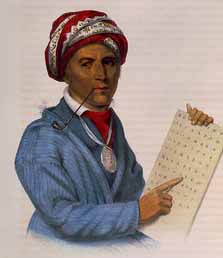
�The exact place and date of Sequoyah's birth are unknown, as no written record exists. Speculation and guess-work by historians place his birth at some point between 1760 and 1776. As for the location, speculation places it in either Tennessee, Georgia, North Carolina, Alabama or South Carolina. James Mooney, a prominent anthropologist and historian of the Cherokee people, quotes a cousin in saying that Sequoyah and his mother spent his early years in the village of Tuskegee in TenThe name Seqouyah or Sikway is believed to be derived from the Cherokee word Sikway meaning 'pig'. Possibly this is a reference to a child-hood deformity or a later injury that left Sequoyah crippled. Again, scholars agree that he was crippled but the reason is disputed.
Of his mother, it is known that she was a Cherokee and belonged to the Paint Clan and Mooney states that she was the niece of a Cherokee chief. His father was either white or part white and part Native American. Again, sources differ as to the exact identity of Sequoyah's father, but many (including Mooney) suggest that he was possibly a fur trader or the son of Christopher Gist, a scout for George Washington.
There is some indication, however, that Sequoyah and his mother were abandoned by his father, this may be indicated by the fact that Sequoyah did not speak English. At some point before 1809, Seuqoyah moved to the Wills Valley in Alabama. There he established his trade as a silversmith. He may have fought in the Creek War between 1813 and 1814 against the Red Sticks. Of course if he was crippled, likely he would not have fought, but historians speculate that he may have been wounded in battle, thus leaving him crippled.
"Talking Leaves" and a syllabary
As a silversmith, Sequoyah dealt regularly with white people who had settled in the area. Often, the Native Americans were impressed by their writing, referring to their correspondence as "talking leaves." Around 1809, Sequoyah began work to create a system of writing for the Cherokee language.
After attempting to create a character for each word, Sequoyah decided to divide each word into syllables and create a character for each syllable. Utilizing the Roman alphabet and quite possibly the Cyrillic alphabet, he created 85 characters to respresent the various syllables. This work would take Sequoyah 12 years to complete.
There was some doubt amongst his fellow Cherokee as to the worthiness of his alphabet. In order to prove his creation, Sequoyah taught his daughter Ah-yo-ka how to read and write in Cherokee. After amazing locals with his new writing, Sequoyah attempted to display his feat to tribal medicine men only to be rebuffed by them for being possessed by evil spirits. Sequoyah finally proved his feat to a gathering of Chickamaugan warriors. Quickly news of the syllabary spread and the Cherokee were filling schools in order to learn the new language. By 1823 the syllabary was in full use by the The Cherokee Nation. The language was made the official language of the Cherokee Nation in 1825.
After the acceptance of his syllabary by the nation in 1825, Sequoyah moved to the new Cherokee territory in Arkansas. There he set up a blacksmith shop and a salt works. He continued to teach the syllabary to anyone who came to him. In 1828, Sequoyah journeyed to Washington, D.C. as part of a delegation to make a treaty for land in Oklahoma.
His trip brought him into contact with representatives from other tribes of Native Americans around the nation. With these meetings he decided to create a syllabary for universal use among all Native American tribes. With this in mind, Sequoyah began to journey to areas of present day Arizona and New Mexico seking tribes there.
In addition, Sequoyah dreamed to see the splintered Cherokee Nation re-united. It was on a trip seeking Cherokees who had moved to Mexico that he died in the summer of 1843.
There were several famous Cherokees in American history, including Sequoyah, who invented the Cherokee writing system. Sequoyah may be the only known person in history to invent a written language single handedly. Sequoyah never learned to speak, read or write the English language. Another famous person with Cherokee ancestry was the humorist Will Rogers. Today, Wes Studi is a well-known actor. Famous Cherokee politicians include Chad 'Corntassel' Smith, Wilma Mankiller and Ross Swimmer. The American blues-rock guitarist, Jimi Hendrix, was of Cherokee descent via his paternal grandmother, Nora Rose Moore. Oral Roberts, a Pentecostal evangelist in the 1950's through the 1990's, is also of Cherokee descent. Journalist and writer Sarah Vowell also has Cherokee ancestors.
A written constitution was adopted, and religious literature flourished, including translations from the Christian scriptures. An Indian newspaper, the Cherokee Phoenix, the first of its kind, began publication in February 1828.
But the Cherokee's rapid acquisition of white culture did not protect them against the land hunger of the settlers. When gold was discovered on Cherokee land in Georgia, agitation for the removal of the Indians increased. In December 1835 the Treaty of New Echota, signed by a small minority of the Cherokee, ceded to the U.S. all their land east of the Mississippi River for $5,000,000. The overwhelming majority of Cherokees repudiated the treaty and took their case to the Supreme Court of the United States. The court rendered a decision favourable to the Indians, declaring that Georgia had no jurisdiction over the Cherokees and no claim to their lands.
Georgia officials ignored the court's decision, and Pres. Andrew Jackson refused to enforce it. As a result, the Cherokees were evicted under the Indian Removal Act of 1830 by 7,000 troops commanded by Gen. Winfield Scott. Some 15,000 Cherokees were first gathered into camps while their homes were plundered and burned by local residents. Then the Indians were sent west in groups of about 1,000, most on foot.
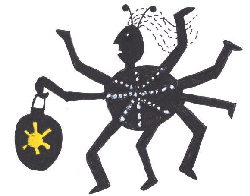
In the beginning there was only blackness, and nobody could see anything. People kept bumping into each other and groping blindly.
They said, "What this world needs is light."
Fox said he knew some people on the other side of the world who had plenty of light, but they were too greedy to share it with others.
Possum said he would be glad to steal a little of it. "I have a bushy tail. I can hide the light inside all my fur."
Then he set out for the other side of the world. There he found the sun hanging in a tree and lighting everything up.
He snuck over to the sun, picked out a tiny piece of light, and stuffed it into his tail. But the light was hot and burned all the fur off.
The people discovered his theft and took back the light, and ever since, Possum's tail has been bald.
"Let me try," said Buzzard.
"I know better than to hide a piece of stolen light in my tail. I'll put it on my head."
He flew to the other side of the world and, diving straight into the sun, seized it in his claws.
He put it on his head, but it burned his head feathers off.
The people grabbed the sun away from him, and ever since that time Buzzard's head has remained bald.
Then Grandmother Spider said, "Let me try!"
First she made a thick-walled pot out of clay.
Next she spun a web reaching all the way to the other side of the world.
She was so small that none of the people there noticed her coming.
Quickly Grandmother Spider snatched up the sun, put it in the bowl of clay, and scrambled back home along one of the strands of her web.
Now her side of the world had light, and everyone rejoiced.
Spider Woman brought not only the sun to the Cherokee, but fire with it.
And besides that, she taught the Cherokee people the art of pottery making.
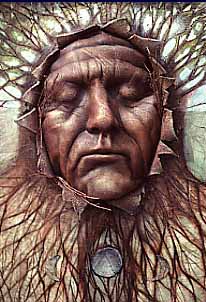
Spider Women